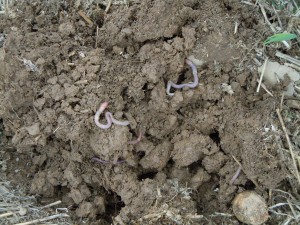Robison Farms in the Greenwood, Indiana area have been no-till farming since the late 1960’s. The field that these videos were taken from has been no-tilled for approximately 20 consecutive years. With the wet spring of 2011 the gentleman that now does the field work for dad decided to chisel plow and disk most of the farm where my brother lives. Thankfully the area where the cover crop plots were was not tilled. In mid-August I decided to dig around in the field where the cover crop plots were and in areas where the field was tilled (again, it had been no-till for approximately 20 consecutive years). Dad tells me that in those 20 years the organic matter has increased by at least one (1) percent. So the soil on this farm should be pretty healthy. In 2010 the soybeans averaged around 55 bu/acre in a very dry year.

I have included three different videos where I am taking earthworm counts in this post and I believe you will find them very interesting.
The first video is of earthworm channels in no-till where we had annual ryegrass as a cover crop.
The second video is taken in an area of the field where I counted earthworm channels where we had no cover crop in the tilled soil.
The third video is where I counted earthworm channels in no-till where we had a cereal rye cover crop.
Observations:
- There were always more earthworms in no-till with cover crops (watch the videos to see how many more…).
- There were more earthworms in the tilled soil than I anticipated.
- The corn looked healthier (with somewhat larger ears) in no-till and with cover crops than in the tilled w/o cover crops area.
- There were more earthworms where there was no-till w/o cover crops than in tilled area w/o cover crops.